You're using an outdated browser. Please upgrade to a modern browser for the best experience.
Please note this is a comparison between Version 1 by YoungPak Lee and Version 2 by Catherine Yang.
Metamaterial absorbers have garnered significant interest due to their unique electromagnetic properties, which facilitate the efficient absorption of electromagnetic radiation in a specific frequency range or multiple frequency ranges. The metamaterial absorbers are designed based on artificially engineered structures that enable tailored absorption properties. These structures might include multiple resonances or incorporate electrical resistive components to achieve broadband absorption.
- metamaterial
- broadband metamaterial absorber
- polarization insensitivity
1. Introduction
Metamaterials have emerged as a class of advanced materials that have made significant contributions to the ongoing progress in science and technology [1]. These materials are artificially-engineered, comprising elemental unit cells with dimensions smaller than the operating wavelength, arranged periodically [2]. The constituent elements of metamaterial structures exhibit distinct electrical and magnetic resonance properties within specific frequency ranges [3]. Consequently, within these resonant frequency ranges, metamaterials manifest extraordinary electromagnetic characteristics which are not obtained with natural materials. Examples of such unique properties include negative refractive index [4], inverse Doppler effect [5], cloaking [6], and electromagnetically-induced transparency (EIT) [7]. The ability to manipulate the resonance properties of each element in the metamaterial structure or to modify the interconnections between these elements allows us precise control over the resultant properties of metamaterial [8][9][10][11][8,9,10,11]. This facilitates the tailoring of the material’s behavior according to the specific requirements and desires of the designer. By strategically adjusting the resonance properties or modifying the structural arrangement, the metamaterials can be engineered to exhibit the desired electromagnetic responses, paving the way for innovative applications in various fields of science and technology [12][13][14][12,13,14].
Metamaterials have garnered significant attention due to their unique and promising properties, one of which is their capability to exhibit the perfect absorption of electromagnetic waves [15]. This intriguing property was demonstrated first by Landy et al., wherein the metamaterial structure was able to absorb electromagnetic waves with a near-perfect efficiency, exhibiting minimal transmission, reflection, and scattering [16]. The unique properties of metamaterial absorbers have led to their adoption in various applications. For instance, in the field of sensing, metamaterial absorbers have been utilized to develop highly-sensitive sensors capable of detecting tiny changes in the environment [17]. In energy harvesting, these absorbers have been employed to capture and convert electromagnetic energy into electrical energy [18]. Moreover, they have also been utilized to develop high-performance bolometers and photo-detectors, with potential applications in imaging and sensing technologies [19][20][19,20]. The metamaterial absorbers are essentially ultrathin structures with dimensions smaller than one-tenth of the operating wavelength [21]. These structures are lightweight and highly flexible, making them easily integrated into existing electronic systems and devices [22][23][22,23]. Additionally, the fabrication process for metamaterial absorbers is highly versatile, allowing us to produce structures with varying shapes, sizes and properties [24][25][26][27][24,25,26,27]. As a result, these absorbers can be tailored to suit the specific application requirements [28].
2. The Principles of the Metamaterial Absorbers in Controlling Single-Peak/Multiple-Peaks/Tailored-Band/Broadband
2.1. Interference Theory
Interference theory is a widely accepted method for determining the absorption properties of metamaterial absorbers. This approach relies on the accumulation of reflections between the top metallic layer and the bottom metallic plate of the absorber [29][44]. Specifically, when the wave directly reflected on the resonator surface interferes destructively with that from multiple reflections, the wave is trapped within the metamaterial structure, leading to a high absorption. This phenomenon results from the constructive and destructive interference of waves, which can be explained by the interference model presented in Figure 1. The model illustrates how the incident wave is reflected off the top metallic layer, creating a reflected wave that interferes with the incident wave. The interference between these waves can be either constructive or destructive, depending on the distance between the top layer and the bottom metallic plate. When the distance is such that destructive interference occurs, it leads to the absorption of waves within the metamaterial structure. By understanding this physical mechanism, researchers can design and optimize the metamaterial absorbers for various applications, including sensing, imaging, and energy harvesting.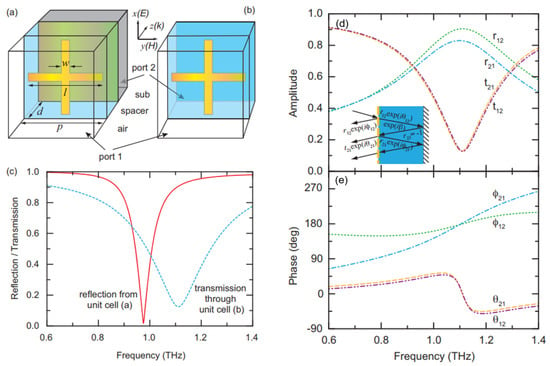
Figure 1. (a) Schematic of the unit cell for a metamaterial absorber, which is repeated in the x and y directions, forming a square array with a periodicity p. (b) Unit cell used to obtain the reflection and transmission coefficients at the air–spacer interface with a cross-resonator array. (c) Solid red curve is the reflection |S11| from unit cell (a) of the metamaterial absorber, and the dashed blue curve is the resonant transmission |S21| through the cross resonator array shown in unit cell (b). (d) Amplitude and (e) phase of the reflection and transmission coefficients at the air–spacer interface with the cross-resonator array, obtained by the numerical simulation based on the unit cell shown in (b). Inset: Multiple reflections and the interference model of the metamaterial absorber, where the cross-resonator array is indicated by the dashed line at the air–spacer interface [29][44].
2.2. Impedance Matching Theory
Metamaterials are distinguished by their complex electric permittivity (ε = ε1 + iε2) and magnetic permeability (μ = μ1 + iμ2). By manipulating the resonance of ε and μ independently, absorption can be achieved for both electric and magnetic fields. Additionally, when ε and μ are matched properly, a metamaterial absorber can be impedance-matched to the free space, effectively minimizing the reflection of waves [16]. The absorption characteristics of metamaterial absorbers, specifically, their ability to achieve perfect absorption within a specific wavelength range, can be elucidated by using the theory of impedance matching [30][45]. This theory enables us to evaluate and determine the frequency at which the reflection is minimized [31][46]. By employing the reflection coefficient S11(ω) and transmission coefficient S21(ω), the researchers can calculate the effective impedance of the metamaterial absorber [30][45]:

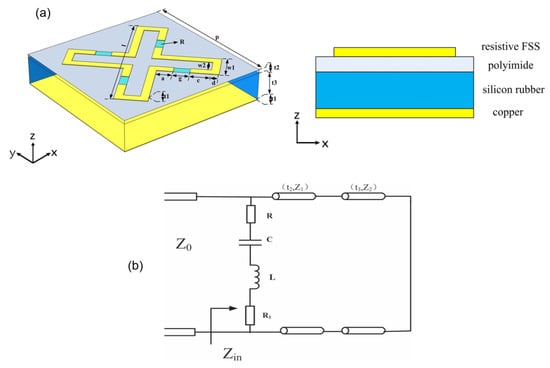
2.3. Controling the Absorption Bandwidth
The tunability of metamaterial absorbers refers to their remarkable capability to adjust and tailor the absorption properties across a wide range of frequencies. This characteristic is achieved through the strategic incorporation of tunable elements within the structure of a metamaterial absorber. By integrating these tunable components, the absorber becomes responsive to external control, allowing for dynamic and real-time adjustments to optimize the performance. Tunable metamaterial absorbers have emerged as a highly promising and versatile solution for controlling and effectively manipulating electromagnetic waves across various frequency bands. Their capability to adapt and modify the absorption characteristics makes them valuable in a multitude of applications, particularly, in the fields of energy harvesting, telecommunication, and sensing [32][33][34][35][36][37][47,48,49,50,51,52]. The principles of tailoring the bandwidth of a metamaterial absorber include manipulating the structural design and material properties of the absorber to achieve the desired absorption characteristics within a specific frequency range. This is made by engineering the resonant properties of the structure, which comprises adjusting the geometry and material composition of the metamaterial unit cell. By enabling the shift of resonant frequency, the tunable structure provides the remarkable capability of achieving absorption at various specific frequencies. This feature allows us to control precisely the absorption bandwidth of the metamaterial absorber. With this capability to adjust the resonant frequency, the absorber can be fine-tuned to target and absorb electromagnetic energy at the desired frequencies. The development of tunable metamaterial absorbers needs the consideration of desired frequency range, tuning mechanism, and overall performance specifications. The successful realization of these absorbers has required the integration of various tuning mechanisms, such as optical [32][47] (Figure 3a), temperature [33][48] (Figure 3b), magnetical [34][49] (Figure 3c), electrical [35][50] (Figure 3d), and mechanical tuning mechanisms [36][51] (Figure 3e), in the metamaterial structure to achieve the desired level of tunability, as shown in Figure 3. The selection of a suitable tuning mechanism depends on several factors, such as the desired frequency range, required level of tunability, and practical constraints associated with the specific application. For instance, the optical tuning mechanism might be preferred for applications that require high-speed modulation and low-power consumption [32][47]. On the other hand, temperature and electrical tunings are more appropriate for applications which need precise and stable tuning over an extended period [33][35][48,50]. Similarly, the magnetical and mechanical tuning mechanisms also have their own special application purposes [34][36][49,51]. The integration of different tuning mechanisms within the metamaterial structure should be accompanied by the careful consideration of the design and fabrication process. This includes the selection of appropriate materials, the optimization of structural parameters, and the implementation of suitable fabrication techniques. The successful implementation of these processes is crucial to achieve the desired level of tunability and overall performance of the metamaterial absorber.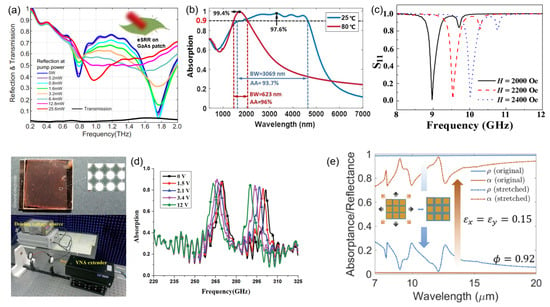
Figure 3. Controlling the absorption band of a metamaterial absorber by using (a) optical [32][47], (b) temperature [33][48], (c) magnetic [34][49], (d) electrical [35][50], and (e) mechanical tuning schemes [36][51]. Blue and red arrows indicate the spectra after stretching.
3. Applications
Metamaterial absorbers have found numerous applications across various fields, due to their unique electromagnetic properties and absorption capabilities. The applications also vary, depending on the single-peak, multi-peak, or broadband absorption characteristics. Narrowband absorbers can be applied for sensing and detection by using the sensitive characteristic of resonance peaks with the surrounding environment, while broadband absorption is more powerful for various applications. Some of their notable applications are as follows.
Antenna Design: Broadband metamaterial absorbers are utilized in antenna design to enhance performance. They can be used to suppress unwanted reflections, reduce the side lobes, and improve the overall efficiency and bandwidth [38][74]. By incorporating the metamaterial absorbers, researchers could achieve improved antenna characteristics and optimize the antenna performance for specific applications. Figure 47a shows a proposed metamaterial antenna structure in the simulation layout and photo of the prototype [39][75]. The antenna employed a configuration of ten metamaterial unit cells, each of which consisted of a pair of series interdigital capacitors and a short-circuited inductive stub by using a metallic interconnection. A lossy substrate FR-4 with a thickness of 0.8 mm, loss-tangent of 0.025 was used to implement a prototype of the proposed planar antenna. The effect of a metamaterial antenna with a substrate-integrated waveguide (SIWs) is demonstrated in Figure 47b by the simulated and measured reflection coefficient (S11) and transmission one (S21). S11 quantifies the impedance matching, and S21 presents the isolation between the two ports. The results illustrate that the reflection and transmission coefficients in the cases with SIWs are much better than those without SIWs. This demonstrates that the reflection and transmission coefficients are significantly improved by employing the SIWs.


Figure 47. (a) Simulation layout and photo of the fabricated prototype. (b) Simulated and measured S-parameters of the metamaterial-inspired antenna before and after applying the SIWs [39][75].
Radar Cross-section Reduction: Broadband metamaterial absorbers play a crucial role in stealth technology by reducing the radar cross-section (RCS) of objects or structures. By absorbing and selectively dissipating incident electromagnetic waves, the metamaterial absorbers can effectively minimize the radar signature of objects, making them less detectable by radar systems [40][76]. This application has significant implications for military and defense research. A coding metasurface is a cutting-edge technology which manipulates electromagnetic waves, based on the cleverly-designed properties of the unit cell called meta-atoms. These meta-atoms were engineered to control the phase, amplitude, and polarization of reflected waves. A broadband coding metamaterial was designed for the RCS reduction, as presented in Figure 48a [41][77]. The RCS was manipulated by the different metamaterial coding sequences, as shown in Figure 48b.


Figure 48.
(
a
) Fabricated coding metasurface and (
) transmission coefficient [77].
Sensing and Detection: Broadband metamaterial absorbers have been explored for sensing and detection applications by using the tailored absorption-frequency characteristic. They can be designed to selectively absorb specific frequencies, enabling us to have enhanced sensitivity and accuracy in various types of sensors. This includes applications in areas such as gas sensing, malaria, glucose, and environmental monitoring [42][43][61,78]. In [44][79], a metamaterial sensor based on a rectangle enclosing adjacent triple split-ring resonators (SRRs) is presented to recognize various oils, fluids and chemicals within the X band. Figure 59 shows the experimental setup for measuring the liquid using the metamaterial sensor, and includes the following details: front view of the fabricated metamaterial-based sensor (Figure 59a), back view (Figure 59b), liquid insertion process (Figure 59c), experimental setup of the waveguide (Figure 59d), sensor attached with the X-band waveguide (Figure 59e), and sample holder attached with an extended guided wave (Figure 59f). S11 results for palm and sunflower oil are in Figure 59g, and for benzene and carbon tetrachloride are in Figure 59h. Depending on the liquid, the resonance frequency of the metamaterial sensor was shifted in both simulation and measurement. Based on this characteristic, the liquid could be detected and classified. In other work, the tunable metamaterial absorber was also applied for the sensing application. Zhang et al. described how the absorption resonances of split-disk metamaterials could be tailored to cover a wide wavelength range of 1.5 to 5.0 µm by adjusting the geometrical configurations [45][80]. The sensor devices, based on these configurations, exhibited high sensitivities of 3312, 3342, 3362, and 3567 nm/RIU, respectively. This finding suggests a promising avenue for the development of optical-gas sensors and biosensors with a high sensitivity.
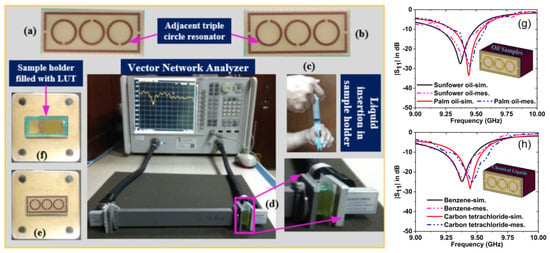

Figure 59. (a) Front view of the fabricated metamaterial-based sensor, (b) back view, (c) liquid insertion process, (d) experimental setup of waveguide, (e) sensor attached with the X-band waveguide, and (f) sample holder attached with an extended guided wave. (g) S11 results for palm and sunflower oil, and (h) benzene and carbon tetrachloride [44][79].
Energy Harvesting: Broadband metamaterial absorbers have shown promise in energy harvesting applications. By efficiently absorbing incident electromagnetic waves across a broad frequency range, they can convert this absorbed energy into usable electrical power. This application has potential in areas such as wireless power transfer, self-powered sensors, and energy harvesting from the ambient electromagnetic radiation [18][46][18,81]. Fowler et al. presented a radio-frequency (RF) energy harvesting device that exhibited a high efficiency [47][82]. The device utilized a metamaterial perfect absorber integrated with Schottky diodes to achieve the efficient conversion of captured RF waves into DC power. The experimental results revealed that the rectenna was capable of generating a power output of 100 µW when subjected to an incident intensity of 0.4 µW/cm2. The design of unit cell of the rectenna-based metamaterial was constructed from an SRR array with Schottky diodes embedded in the gaps. The metamaterial design and current analysis are presented in Figure 610. In other previous work, a tunable perfect metamaterial absorber was introduced for electromagnetic-energy harvesting [48][83]. The absorber consisted of a circular ring with a groove and varactor diodes, providing flexibility and reconfigurability. The proposed tunable structure, despite its simple geometry, achieved a near-perfect absorption of 99.91% and 84.79% at frequencies of 5.01 and 4.79 GHz, respectively. The objective of this study was to demonstrate the collection of electromagnetic energy without polarization concerns by employing the tunable dual-band metamaterial absorber. This kind of absorber can serve as a guide for designing new absorbers at higher frequencies and be applied in various electromagnetic-energy harvesting applications, including power transfer and wireless power transmission.
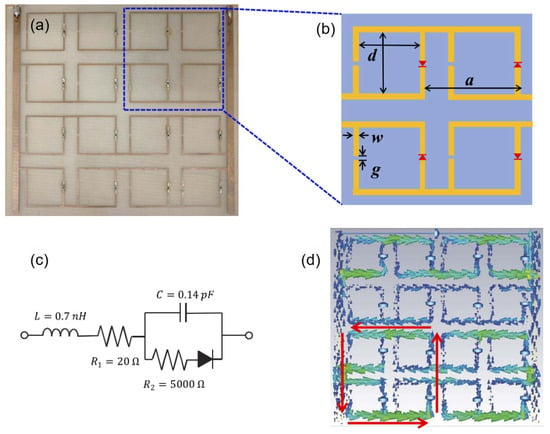

Figure 610. Design of a rectenna-based metamaterial. (a) SRR array with diodes embedded in the gaps, (b) sketch model of the unit cell, (c) equivalent circuit model of the Schottky diode, and (d) surface-current distribution at the resonance frequency [46][81].
Imaging: Broadband metamaterial absorbers have been investigated for imaging applications. By tailoring the absorption properties of the absorber, researchers can obtain improved contrast and resolution in imaging techniques such as MRI (magnetic resonance imaging), terahertz imaging, and microscopy [49][84]. The metamaterial absorbers also find applications in optical devices, such as filters and modulators. In [50][85], a metamaterial structure used to enhance the performance of THz reflectance imaging was investigated. This THz reflectance imaging with metamaterial was used to resolve different regions of mouse brain tissue due to the difference in their refractive index. Figure 610a illustrates the schematic of the THz-reflection measurement process. The metamaterial with polydimethylsiloxane sample was mounted onto a two-dimensional moving stage for a raster scan, and the reflectance images of 60 × 60 pixels with a resolution of 250 µm were obtained by using a THz time-domain spectroscopy system. Figure 711b presents a reflectance image at an incident angle of 65 degrees. This image at a resonance frequency of 1.1 THz exhibited the highest contrast and sensitivity.
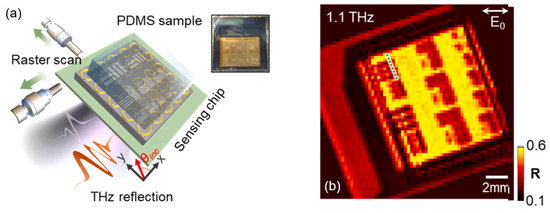

Figure 711. (a) Experimental process for THz-reflection measurement with a motorized raster-scanning stage, and (b) reflectance images at 1.1 THz by using the metamaterial [50][85].
These are just a few examples of the diverse applications of broadband metamaterial absorbers. The ongoing research and developments in this field continue to expand the potential of metamaterial absorbers in various scientific disciplines.
